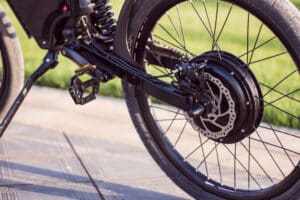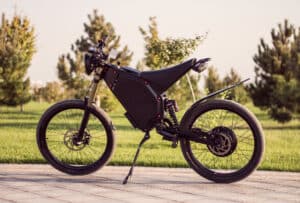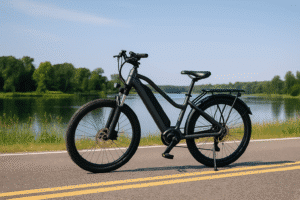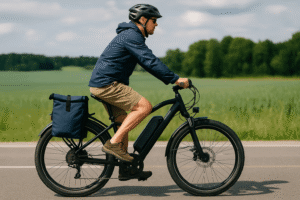Electric dirt bikes are changing how riders think about off-road fun.
They’re quiet, powerful, and require little upkeep compared to gas dirt bikes. But gas bikes still hold their ground when it comes to raw power, range, and that classic riding feel.
I’ve ridden both, and while the electric’s instant torque blew me away, the gas bike still wins for longer trails. So, which one fits you best? Let’s break it down.
What is an Electric Dirt Bike?
An electric dirt bike is a battery-powered off-road motorcycle that uses an electric motor instead of a gas engine. It delivers instant torque, runs quietly, and requires minimal maintenance compared to traditional gas models.
Electric dirt bikes are powered by rechargeable lithium batteries that feed energy to a motor through a controller.
There’s no clutch, gears, or exhaust, just smooth, instant power when you twist the throttle.
Because they’re lighter and quieter, they’ve become popular with beginners and riders who live in noise-sensitive areas.
You can charge them at home, and newer models can go 40–80 miles per charge, depending on the terrain and battery size.
Read more: Best electric dirt bike for adults
Pros of Electric Dirt Bikes
Electric dirt bikes are easy to ride, efficient, and surprisingly powerful for their size.
- Instant torque with zero lag
- Virtually silent for neighborhood or trail riding
- Low maintenance (no oil changes or engine tuning)
- Eco-friendly with zero emissions
- Lightweight and beginner-friendly handling
- Cheaper to operate long-term than gas bikes
Cons of Electric Dirt Bikes
They’re not perfect, especially if you ride far or competitively.
- Shorter range compared to gas bikes
- Long charging times between rides
- Higher upfront price
- Fewer charging stations in remote areas
- Heavier battery packs can add weight in some models
What is a Gas Dirt Bike?
A gas dirt bike is a traditional off-road motorcycle powered by an internal combustion engine that burns fuel to generate power. These bikes are known for their longer range, fast refueling, and high performance in competitive riding.
Gas dirt bikes have been the standard for decades. They use engines that burn gasoline and require gear shifting, clutch control, and regular maintenance.
Most riders love their responsiveness and that signature exhaust sound.
They also deliver steady power for hours of riding, making them a favorite for motocross, enduro, and trail competitions.
While they’re heavier and noisier, they remain unmatched for endurance and performance on rough terrains.
Pros of Gas Dirt Bikes
Gas dirt bikes deliver consistent performance and long ride times.
- Longer range (80–150 miles on a tank)
- Quick refueling ready to go in minutes
- Higher top speeds
- Widely available parts and service options
- Proven reliability in racing and endurance rides
Cons of Gas Dirt Bikes
They require more effort and cost to keep running smoothly.
- Regular maintenance (oil, filters, spark plugs)
- Louder engine noise and more vibration
- Higher fuel and upkeep costs
- Emissions from burning fuel
- Can feel heavier and harder to control for beginners
Electric Dirt Bike vs Gas Dirt Bike: Key Differences
Electric dirt bikes are quieter, easier to maintain, and offer instant torque, while gas dirt bikes deliver longer range, faster top speeds, and quick refueling.
Electric models are ideal for beginners and casual riders, whereas gas bikes suit racers and those who prefer raw power and endurance.
If you’ve ever ridden both, you know how different they feel. Electric bikes hit instantly with smooth, silent torque, while gas bikes come alive with that roaring throttle and vibration through the handlebars.
Both have their strengths, and your choice often depends on how and where you ride.
Here’s a quick breakdown of the main differences:
| Feature | Electric Dirt Bike | Gas Dirt Bike |
|---|---|---|
| Power Delivery | Instant torque with no lag or gears | Progressive power with clutch and gears |
| Top Speed | Around 50–60 mph depending on model | Usually 70–90 mph or higher |
| Range | 1–3 hours or 40–80 miles per charge | 80–150 miles per tank |
| Refueling / Charging | Takes 1–10 hours to recharge battery | Refuels in a few minutes at gas stations |
| Maintenance | Low maintenance, no oil or filters needed | Regular oil changes, filters, and tune-ups |
| Noise Level | Nearly silent, ideal for neighborhoods | Loud exhaust sound, adds to thrill for some |
| Environmental Impact | Zero emissions while riding | Produces CO₂ and other pollutants |
| Ease of Use | Twist-and-go operation, beginner-friendly | Manual shifting, better for experienced riders |
| Operating Cost | Low (around $20–$40 yearly in electricity) | High (around $400–$800 yearly in fuel) |
| Ideal For | Beginners, casual riders, and eco-conscious users | Racers, long-distance riders, and power seekers |
Now let’s break down these differences in more detail.
Power and Acceleration
Electric dirt bikes deliver power instantly. There’s no clutch or gear shifting, so when you twist the throttle, the motor responds right away. That makes them especially fun on trails and tight turns where quick bursts of torque help you maneuver easily.
Most electric dirt bikes can speed up to 50–60 mph, depending on the model and terrain.
Gas dirt bikes, on the other hand, build power gradually. You need to shift through gears and manage throttle response. This gives you more control over how the power hits, which many experienced riders prefer for racing or high-speed runs.
Many gas dirt bikes can speed up to 70–90 mph, offering stronger top-end performance for open tracks.
From my own rides, the instant punch from an electric bike is addictive; it feels like you’re flying off the line. But gas bikes still win in sustained power over long stretches.
Range and Refueling
When it comes to endurance, gas bikes still take the lead. You can ride for hours, stop at a gas station, and be back on the trail in minutes.
Electric dirt bikes rely on battery capacity, typically lasting 1–3 hours depending on speed and terrain. Charging takes longer, anywhere from 1 to 10 hours, but some models now allow fast charging or quick battery swaps. If your riding area has charging access, the gap is closing fast.
Maintenance and Durability
Electric bikes require almost no mechanical maintenance, no oil changes, air filters, or valve adjustments. You just need to check the chain, tires, and occasionally the battery health.
Gas dirt bikes demand regular upkeep: oil changes, spark plug checks, air filter cleaning, and sometimes piston replacements after heavy use.
These costs add up over time, which is why many casual riders prefer the simplicity of an electric.
Noise and Riding Experience
Electric dirt bikes are nearly silent. You hear only a soft whir from the motor and the crunch of dirt under the tires. It’s perfect for early-morning rides or noise-restricted areas.
Gas bikes roar to life with that signature sound and smell of fuel. Many riders love that, it’s part of the experience. But for city trails or suburban areas, the noise can quickly draw unwanted attention.
Environmental Impact
Electric dirt bikes produce zero emissions while riding and use far less energy overall. Charging them for a year might cost less than a single tank of gas for a car. However, battery production and disposal still carry some environmental cost.
Gas bikes emit carbon dioxide and other pollutants each time you ride. Over time, that adds up, especially for frequent riders. If sustainability matters to you, the electric option clearly wins.
Ease of Use and Skill Level
Electric dirt bikes are easier to handle, just twist and go. That makes them a favorite for beginners, kids, and casual riders. You can focus on balance and control instead of gear shifts.
Gas dirt bikes, with their gears and clutch, require more skill and coordination. They’re great for riders who enjoy full control and mechanical feedback.
Once you master the rhythm, it’s incredibly satisfying, but there’s a learning curve.
Read more: Can you ride an electric dirt bike on the road?
Cost of Ownership: Which One Saves You More Money?
Electric dirt bikes usually cost more upfront but save money long-term thanks to lower maintenance and no fuel expenses, while gas dirt bikes are cheaper to buy but cost more to maintain and run over time.
In my experience, the difference really shows after the first year. Gas bikes may seem like a better deal at the start, but once you add up oil changes, fuel, and parts, the costs climb quickly.
Electric dirt bikes, on the other hand, need very little upkeep, no oil, no spark plugs, and no carburetor cleaning. Charging an e-bike battery for a full year might cost less than a single weekend of gas refills for a traditional bike.
Here’s how they compare side by side:
| Cost Factor | Electric Dirt Bike | Gas Dirt Bike |
|---|---|---|
| Initial Price | $4,000–$12,000 | $3,000–$10,000 |
| Annual Fuel or Charging Cost | $20–$40 for electricity | $400–$800 for fuel |
| Annual Maintenance | $50–$150 (chain, tires, brake pads) | $300–$700 (oil, filters, engine parts) |
| Battery or Engine Overhaul | Battery replacement every 5–7 years ($500–$1,000) | Engine rebuild after 300–500 hours ($1,000+) |
| Long-Term (5-Year) Cost | ≈ $5,000–$7,000 total | ≈ $7,000–$10,000 total |
Which Is Better for You?
Both electric and gas dirt bikes have their place. The better choice depends on how you ride, how often, and what you value most: convenience or endurance.
Choose an Electric Dirt Bike If You:
- Want a quiet, low-maintenance ride
- Plan to ride near neighborhoods or noise-sensitive trails
- Prefer instant acceleration and smooth handling
- Don’t want to deal with gears, clutch, or oil changes
- Care about reducing emissions and running costs
- Ride casually or for short trail adventures
Choose a Gas Dirt Bike If You:
- Ride long distances or in remote areas
- Enjoy racing, motocross, or competitive off-roading
- Want fast refueling and longer endurance
- Prefer the classic sound and feel of a combustion engine
- Don’t mind regular maintenance or higher running costs
Final Words
Both electric and gas dirt bikes bring something exciting to the table.
Electric dirt bikes are clean, quiet, and simple to maintain, making them perfect for everyday riders and younger beginners.
Gas bikes still rule in raw performance and range, and they’re often the top pick for pros and adventure riders.
If you asked me which one I’d keep in my garage, I’d say both. The electric bike for local trails and quick rides after work, and the gas bike for full-day adventures.
Your best choice comes down to how you ride and what kind of experience you want every time you hit the dirt.
FAQs
Are electric dirt bikes faster than gas?
Not usually. Most electric dirt bikes top out around 50–60 mph, while gas models can reach 70–90 mph or more. However, electric bikes accelerate much quicker off the line thanks to instant torque, making them feel faster in short bursts.
How long does an electric dirt bike battery last?
An electric dirt bike battery typically lasts 1 to 3 hours of ride time per charge, depending on terrain and speed. Over its lifespan, a quality lithium battery can handle 500 to 1,000 charge cycles before it starts losing capacity.
Can electric dirt bikes go off-road?
Yes, electric dirt bikes are built for trails, hills, and rough terrain just like gas models. Their torque delivery actually makes them great for climbing and tight trail control, though range can drop faster on steep or muddy paths.
Are electric dirt bikes waterproof?
Most electric dirt bikes are water-resistant but not fully waterproof. They can handle splashes, puddles, and light rain, but submerging the battery or motor could cause damage. Always check for an IP rating (like IP65 or IP67) before riding through deep water.
Which lasts longer, electric or gas dirt bikes?
Gas dirt bikes usually last longer mechanically since parts can be replaced and rebuilt over time. Electric bikes have fewer moving parts and need less maintenance, but their lifespan depends on the battery’s health and the replacement cost after several years.
Michael Josh is a hands-on e-bike tester and reviewer at BoltBikers, known for putting every model through real-world rides before sharing his thoughts. With a sharp eye for performance, comfort, and build quality, he helps the team choose which bikes are worth featuring. Backed by years of experience in tech and gear reviews, Michael brings trusted, honest insights to help readers find the right e-bike for their needs.








